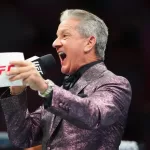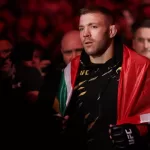THE main event of UFC 236 is billed as a rematch but a lot of fight fans aren’t thinking of it in that way. The Max Holloway and Dustin Poirier who met on the undercard at UFC 143—seven years ago—are so far removed from today’s incarnations that the first fight is unlikely to have any bearing on this one.
Holloway came into the UFC as a highly touted striking prospect and did his part, piecing Poirier up with counter left hooks in the early going. Poirier, meanwhile, was the big banger—lacking in science but willing to bull rush until something stuck. A poorly thought out flying knee from Holloway saw Poirier press the youngster to the fence, get the takedown and secure a mounted triangle choke for the finish.
After their paths diverged, both men suffered a loss to the rising superstar, Conor McGregor. Holloway became the first man to take McGregor the distance but also looked lost and overly defensive at many points in the fight, while Poirier quickly succumbed to the vaunted McGregor left hand. But it is the way that both men learned from their losses and rebuilt themselves that created the circumstances for this weekend’s fight.
Max Holloway remained at featherweight and upped his work rate, becoming one of the most overwhelming and varied strikers in MMA. He is capable of working from both stances and has footwork and ring awareness sharp enough to avoid getting trapped along the cage as he was against McGregor. Not only has there been astonishing overall improvement in Holloway’s game, but his team has done a brilliant job of game planning for each opponent specifically.
Against Cub Swanson, Holloway switched stances often and allowed Swanson to come to him, intercepting him with check hooks and knees. Against Anthony Pettis, Holloway pushed a higher pace and kicked far more readily. Against Jose Aldo, Holloway fought entirely orthodox, barely kicked, and focused on feinting and jabbing to draw counter combinations from the featherweight great until he was gasping for a break.
Sometimes Holloway is righty, sometimes lefty, sometimes Holloway is the aggressor, other times he’s passive. Wherever a thread comes loose at any point, Holloway will pick at it until there’s nothing left. Poor old Brian Ortega came in with some defensive flaws, and left with nothing but 400 punches worth of swelling. It was as if no one had told Holloway that he was supposed to be cautious of Ortega’s punching power.
Dustin Poirier, meanwhile, decided that the cut to featherweight was too much and moved up to lightweight. He had a hit and miss run there, looking bad against Joe Duffy and getting knocked out cold by Michael Johnson, before something remarkable happened. Poirier had been all shifting punches and bum rushes, but he suddenly began developing a jab and striking from an appropriate distance.
Everything about Poirier that had been dangerous—his powerful kicks, his thunderous punches, his sturdy chin and his deceptively slick clinch work—no longer came with a qualifier about his unorthodox, sloppy technique. In the space of a few fights Poirier had just become very, very good and it was rather alarming to watch. Jim Miller, Justin Gaethje and Eddie Alvarez all found themselves getting skewered on the end of a jab that hadn’t existed just a few fights earlier, and countered with Poirier’s thudding power punches whenever they tried to press past this jab.
Hypothetical Gameplans
Max Holloway has one of the most educated jabs in mixed martial arts, but he tends to work his magic with it against orthodox opponents out of his orthodox stance. His game out of southpaw is impressive but understandably lacks the depth and comfort of his main stance. Poirier is curiously in the opposite position—where he, as a southpaw, has jabbed best against orthodox opponents like Gaethje and Alvarez, in a scenario where the clashing of lead hands should make jabbing effectively a more difficult task.
However, Poirier has always had more trouble with his southpaw opponents than orthodox ones—so before the fight even begins there is a fascinating will he, won’t he question over Holloway choosing to fight southpaw as he did through the entire Cub Swanson fight.
While the first fight did take place a lifetime ago, Poirier’s tendency to lead with his face when he gets into exchanges is still very real, and the counter lead hook is still a speciality of Holloway. It would be good to see Holloway try to fight at an extended range and attempt to draw Poirier into overcommitting and eating counter punches. Holloway hasn’t always used elbows as readily as he could, but as Poirier will often grit his teeth through a punching exchange, trying to cut him up rather than simply knock him out could be a wise investment.
As Poirier is always willing to hit a takedown to change up how a round is going, kicking is probably going to be something Holloway approaches cautiously in this fight, but he would do well to utilize his low line side kick into Poirier’s lead leg—this is a difficult kick to grab a hold of and is very useful for jamming a fighter from entering a close range. It should also serve well as a counter measure to Poirier’s own kicking game, which is mainly about short, digging round kicks to the body from the end of Poirier’s jabbing range. Essentially taking away that range that Poirier has found—where everything he already had has started to come together—is a great idea for the more mobile and graceful mover, Holloway.
For Poirier, the fence is undoubtedly his friend. While he absolutely should go forward and try to put his jab and sniper left straight on Holloway’s chin, he will probably do better if he uses the cage to cut off Holloway’s movement options. Not only in terms of striking—removing Holloway’s retreat and really hampering that lean-back counter left hook—but in terms of wrestling. Poirier’s wrestling doesn’t blow anyone’s mind because it isn’t all out domination like Khabib Nurmagomedov’s, but he does a great job of trapping opponents on the fence, forcing them to cover up, and then hitting a short level change onto their hips to pull out their legs and sit them on their butt.
It isn’t always spectacular but these short double legs allowed him to take down and rough up Joe Duffy and Anthony Pettis, and he knocked down Diego Brandao by hitting one such takedown and allowing Brandao to immediately rebound up to his feet and into the path of a left hook. The mix between power punching flurries and level changes along the fence could be a great decision for Poirier.
Furthermore, Holloway has always neglected his opponent’s low kicks. Many of his opponents have landed at alarmingly high percentage because Max—as a good jabber—is busy using his feet for other things than checking low kicks. If Poirier cannot establish his jab, or Holloway is too elusive to put on the fence, feinting with the hands and chopping out the trailing leg (Shogun Rua vs Lyoto Machida style) could be a way to hamper Holloway’s mobility.
The winner of this fight has been promised the usual interim title belt and a shot at Khabib Nurmagomedov for the real thing, but you know well enough by this point that anything could happen to prevent that fight happening. The chance for Conor McGregor to jump in for a rematch with either Poirier or Holloway if they win is just too obvious to think this will all play out smoothly. All we can say for sure is that one of the most impressive technical strikers in the UFC to date and one of the sport’s most gifted knockout punchers will be throwing down at UFC 236 and you probably don’t want to miss it.



